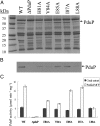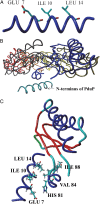Interactions between the termini of lumen enzymes and shell proteins mediate enzyme encapsulation into bacterial microcompartments
- PMID: 22927404
- PMCID: PMC3443165
- DOI: 10.1073/pnas.1207516109
Interactions between the termini of lumen enzymes and shell proteins mediate enzyme encapsulation into bacterial microcompartments
Abstract
Bacterial microcompartments (MCPs) are a widespread family of proteinaceous organelles that consist of metabolic enzymes encapsulated within a protein shell. For MCPs to function specific enzymes must be encapsulated. We recently reported that a short N-terminal targeting sequence of propionaldehyde dehydrogenase (PduP) is necessary and sufficient for the packaging of enzymes into a MCP that functions in 1,2-propanediol (1,2-PD) utilization (Pdu) by Salmonella enterica. Here we show that encapsulation is mediated by binding of the PduP targeting sequence to a short C-terminal helix of the PduA shell protein. In vitro studies indicated binding between PduP and PduA (and PduJ) but not other MCP shell proteins. Alanine scanning mutagenesis determined that the key residues involved in binding are E7, I10, and L14 of PduP and H81, V84, and L88 of PduA. In vivo targeting studies indicated that the binding between the N terminus of PduP and the C terminus of PduA is critical for encapsulation of PduP within the Pdu MCP. Structural models suggest that the N terminus of PduP and C terminus of PduA both form helical structures that bind one another via the key residues identified by mutagenesis. Cumulatively, these results show that the N-terminal targeting sequence of PduP promotes its encapsulation by binding to MCP shell proteins. This is a unique report determining the mechanism by which a MCP targeting sequence functions. We propose that specific interactions between the termini of shell proteins and lumen enzymes have general importance for guiding the assembly and the higher level organization of bacterial MCPs.
Conflict of interest statement
The authors declare no conflict of interest.
Figures





Similar articles
-
The function of the PduJ microcompartment shell protein is determined by the genomic position of its encoding gene.Mol Microbiol. 2016 Sep;101(5):770-83. doi: 10.1111/mmi.13423. Epub 2016 Jun 7. Mol Microbiol. 2016. PMID: 27561553 Free PMC article.
-
Short N-terminal sequences package proteins into bacterial microcompartments.Proc Natl Acad Sci U S A. 2010 Apr 20;107(16):7509-14. doi: 10.1073/pnas.0913199107. Epub 2010 Mar 22. Proc Natl Acad Sci U S A. 2010. PMID: 20308536 Free PMC article.
-
Linking the Salmonella enterica 1,2-Propanediol Utilization Bacterial Microcompartment Shell to the Enzymatic Core via the Shell Protein PduB.J Bacteriol. 2022 Sep 20;204(9):e0057621. doi: 10.1128/jb.00576-21. Epub 2022 May 16. J Bacteriol. 2022. PMID: 35575582 Free PMC article.
-
Prokaryotic Organelles: Bacterial Microcompartments in E. coli and Salmonella.EcoSal Plus. 2020 Oct;9(1):10.1128/ecosalplus.ESP-0025-2019. doi: 10.1128/ecosalplus.ESP-0025-2019. EcoSal Plus. 2020. PMID: 33030141 Free PMC article. Review.
-
Diverse bacterial microcompartment organelles.Microbiol Mol Biol Rev. 2014 Sep;78(3):438-68. doi: 10.1128/MMBR.00009-14. Microbiol Mol Biol Rev. 2014. PMID: 25184561 Free PMC article. Review.
Cited by
-
Bacterial microcompartments.Nat Rev Microbiol. 2018 May;16(5):277-290. doi: 10.1038/nrmicro.2018.10. Epub 2018 Mar 5. Nat Rev Microbiol. 2018. PMID: 29503457 Free PMC article. Review.
-
Bioinformatic characterization of glycyl radical enzyme-associated bacterial microcompartments.Appl Environ Microbiol. 2015 Dec;81(24):8315-29. doi: 10.1128/AEM.02587-15. Epub 2015 Sep 25. Appl Environ Microbiol. 2015. PMID: 26407889 Free PMC article.
-
Structural and kinetic characterization of (S)-1-amino-2-propanol kinase from the aminoacetone utilization microcompartment of Mycobacterium smegmatis.J Biol Chem. 2018 Dec 21;293(51):19909-19918. doi: 10.1074/jbc.RA118.005485. Epub 2018 Oct 25. J Biol Chem. 2018. PMID: 30361441 Free PMC article.
-
Glycyl Radical Enzyme-Associated Microcompartments: Redox-Replete Bacterial Organelles.mBio. 2019 Jan 8;10(1):e02327-18. doi: 10.1128/mBio.02327-18. mBio. 2019. PMID: 30622187 Free PMC article. Review.
-
Encapsulation mechanisms and structural studies of GRM2 bacterial microcompartment particles.Nat Commun. 2020 Jan 20;11(1):388. doi: 10.1038/s41467-019-14205-y. Nat Commun. 2020. PMID: 31959751 Free PMC article.
References
-
- Kerfeld CA, Heinhorst S, Cannon GC. Bacterial microcompartments. Annu Rev Microbiol. 2010;64:391–408. - PubMed
-
- Yeates TO, Kerfeld CA, Heinhorst S, Cannon GC, Shively JM. Protein-based organelles in bacteria: Carboxysomes and related microcompartments. Nat Rev Microbiol. 2008;6:681–691. - PubMed
-
- Price GD, Badger MR, Woodger FJ, Long BM. Advances in understanding the cyanobacterial CO2-concentrating-mechanism (CCM): Functional components, Ci transporters, diversity, genetic regulation and prospects for engineering into plants. J Exp Bot. 2008;59:1441–1461. - PubMed
-
- Bobik TA. Polyhedral organelles compartmenting bacterial metabolic processes. Appl Microbiol Biotechnol. 2006;70:517–525. - PubMed
Publication types
MeSH terms
Substances
Grants and funding
LinkOut - more resources
Full Text Sources
Other Literature Sources
Miscellaneous

